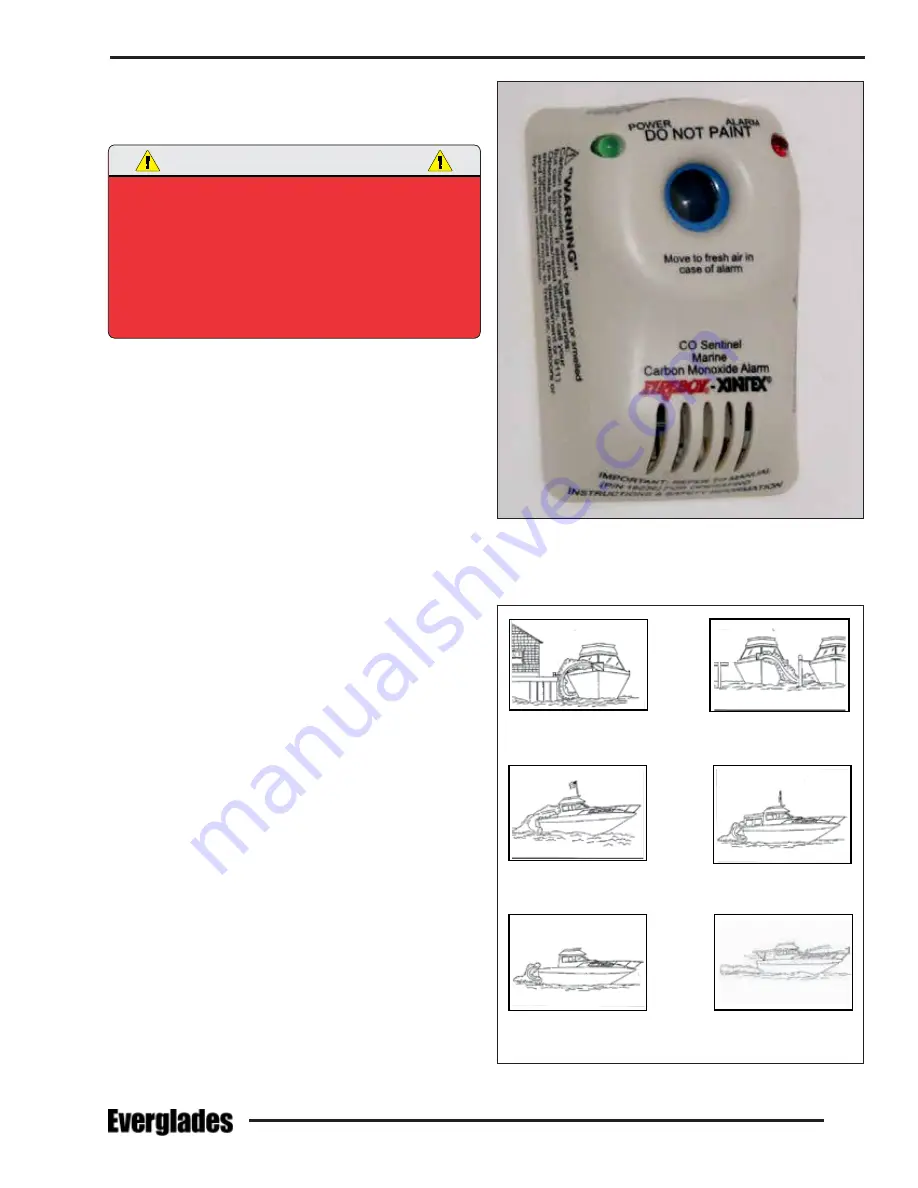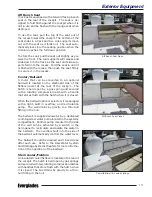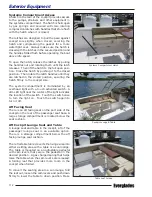
99
Ventilation System
10.3 Carbon Monoxide
& Proper Ventilation
DANGER
FAILURE TO PROPERLY VENTILATE THE BOAT WHILE THE
ENGINES OR GENERATOR ARE RUNNING MAY PERMIT
CARBON MONOXIDE TO ACCUMULATE WITHIN THE CABIN
AND OPEN AREAS OF YOUR BOAT. CARBON MONOXIDE
IS A COLORLESS AND ODORLESS GAS THAT IS LETHAL
WHEN INHALED. CARE MUST BE TAKEN TO PROPERLY
VENTILATE THE BOAT AND TO AVOID CARBON MONOXIDE
FROM ACCUMULATING IN THE BOAT WHENEVER AN ENGINE
IS RUNNING.
A by-product of combustion, carbon monoxide
(CO) is invisible, tasteless, odorless and is pro-
duced by all engines and gas heating and cooking
appliances. The most common sources of CO on
boats are gasoline engines, auxiliary generators
and propane or butane stoves. These produce
large amounts of CO and should never be operated
while sleeping. The hazard also may be created
by a boat nearby whose exhaust fumes are enter-
ing your boat. Boats also have a problem due to
the “station wagon effect” where engine exhaust
fumes are captured in the vacuum or low pres-
sure area, usually the cockpit, bridge deck and
cabin, that can be created by the forward speed
of the boat.
Boats underway should close all aft facing hatches
and doors. The forward facing deck hatch should
be open whenever possible to help pressurize
the living spaces of the boat. No sleeping in the
cabin should be permitted while underway. Proper
ventilation should be maintained on the bridge
deck by opening windshield or forward clear con-
nector panel as far as possible to help pressurize
the cockpit area. The canvas drop or aft curtain
must be removed and the side curtains should
be opened or removed to increase air flow and
maintain proper ventilation whenever the engines
are running.
Under no circumstances should
the engines be operating with side curtains
closed and the aft or drop curtain installed.
Extreme caution must be taken while at anchor
or in a slip when an auxiliary power generator is
operating. Wind still nights can easily allow ex-
haust fumes, containing high concentrations of
CO, from the generator on your boat or from an
adjacent boat’s generator to enter the boat. The
exhaust fumes may enter your boat through open
hatches or windows.
Typical Carbon Monoxide Detector & Alarm
Back Drafting / Station Wagon
Effect - at cruising speed with
no forward ventilation
Back Drafting / Station Wagon
Effect - at cruising speed with
canvas closed
Slow Speed or Boat Stopped
w/ engines running - CO can
accumulate in cabin, cockpit &
bridge
Desired Air Flow Through the
Boat
Onboard Generator Exhaust -
exhaust accumulates because
of bulkhead.
Nearby Generator Exhaust -
wind carries exhaust to the
other boat
Summary of Contents for 340 DC
Page 1: ...OWNER S MANUAL 340 DC...
Page 2: ...2 Revision 0 11 07 2018...
Page 14: ...14 NOTES...
Page 22: ...22 NOTES...
Page 25: ...25 Operation...
Page 86: ...86 NOTES...
Page 102: ...102 NOTES...
Page 122: ...122 NOTES...
Page 130: ...130 NOTES...
Page 149: ...149 MAINTENANCE LOG Appendix B Hours Date Dealer Service Repairs...
Page 150: ...150 Maintenance Log Hours Date Dealer Service Repairs...
Page 151: ...151 Maintenance Log Hours Date Dealer Service Repairs...
Page 152: ...152 Maintenance Log Hours Date Dealer Service Repairs...
Page 153: ...153 Maintenance Log Hours Date Dealer Service Repairs...
Page 154: ...154 Maintenance Log Hours Date Dealer Service Repairs...
Page 155: ...155 Appendix C BOATING ACCIDENT REPORT...
Page 156: ...156 Boating Accident Report...
Page 157: ...157 Boating Accident Report...
Page 158: ...158 NOTES...
Page 160: ...160 NOTES...
Page 167: ...CAUSE AND SOLUTION...
















































